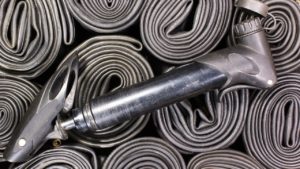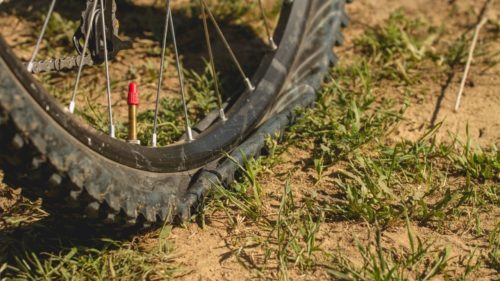There’s been a huge rise in popularity with tubeless tires across all biking disciplines. Many people believe this is the future of riding, and the only way to truly get a more comfortable ride with less of a chance of a flat tire.
Tubeless tires are definitely on the rise, and there are plenty of pros for customers to experience. Are they the right choice for every single rider out there?
With any type of upgrade, there are some different things to consider before going through with it. The pros generally outweigh the cons, but having a better understanding can help people make the best decision for them.
My GO TO Tire Sealant (Amazon)
Pros of Tubeless Tires
Manufacturers have been singing the praises of tubeless tires for quite some time. Not only are they motivated by making sales, but they know that they are getting positive feedback as well.
What are the major positives of going tubeless once and for all? These pros all make a difference for casual riders, as well as those riding professionally. Many could use the extra help with a few of these pros as they go on a ride.
Comfort
Tubeless tires are, generally speaking, the more comfortable choice for all types of riders out there. Comfort is one thing that a lot of riders really hope to have, especially if they are casually riding for exercise and overall enjoyment.
It makes more of a difference off-road than on-road, but both types of riding can be smoothed out with tubeless options.
A lot of this is related to being able to lower the tire pressure because there’s no inner tube. Without an inner tube, there’s less of a chance of anything happening because of major impact.
This gives riders a bit of a floating experience that so many people enjoy. It’s something that can really make a difference in how a person goes about their business and rides on a consistent basis.
The weight of the bike overall also contributes to comfort. There is more on losing weight listed below, but comfort is all about being able to control a bike the best way possible.
Instead of feeling like there are times when the bike is taking over, being able to properly handle a bike is a positive.
Reduce Chances of a Flat Tire

Flat tires can happen for a variety of reasons. Some are impossible to avoid, such as getting a nail that goes directly through the tire itself. However, there are a few instances where flats happen that can be avoidable with the use of a tubeless tire.
With an inner tube, there is an opportunity for there to be a pinch puncture with the tire. This is when the inner tube gets squeezed up against the rim, causing a snake bite type of hole that instantly drains the tire of its air.
Fixing this is a huge hassle, and sometimes can’t be done at all. Riders are left to ask for assistance and get back an alternate way. However, this entire risk can be avoided with a tubeless tire setup.
This is just another reason why riders go with tubeless tires off-road, but is the main reason why cyclists on the road do so as well.
If for some reason there is a flat tire with a tubeless option, sealant is the way to go. Simply patch up a tire and go from there, and riding will be easy once again.
Dealing with any type of flat tire is always a huge negative, but it’s a much easier process to fix everything and move on with the tubeless option.
Instead of not knowing if there is a problem with the inner tube or the tire itself, everyone knows right away that the tire was compromised when there is a flat with a tubeless option.
Less Rolling Resistance

Rolling resistance is a little bit hard to define without getting too specific. It directly relates to inertia created by the bike and the rider, and it will impact acceleration and speed while riding.
Most riders want as little rolling resistance as possible, and that’s what they will get with tubeless tire set ups.
This is because there is no longer that extra bit of friction between the inner tube and the casing. Since it is eliminated, the bike seems like it will pick up speed a little bit faster than with a traditional setup.
It might not be that much of an impact, but every little bit of an edge counts for people who are going as fast as possible.
Lighter Weight
This is pretty obvious, but when material is removed from a tire, it is automatically going to be a little bit lighter. It’s not like inner tubes in a bike tire are that heavy, but for those looking to shed as much weight as possible, it does make a difference.
Look at performance bikes and those who race for a living, and they are almost always riding tubeless. They understand that an edge is an edge, and just a little bit of a change in weight can make riding around that much easier.
A lot of bikes that end up being lighter don’t have the opportunity to carry as much weight. With tubeless tires, that’s not the case at all. They can carry just as much weight as tires with inner tubes, so there are no sacrifices in that regard.
Tubeless Tire Cons

Tubeless tires are not all positive improvements to any type of riding. In fact, there are some people who have held off because of the cons list below.
While there will always be some risk involved with going with either tire setup, most people believe that the cons of tubeless tires are fewer and farther between than those with inner tubes.
Installation Is a Little Tricky
The first time a person is in charge of installing tubeless tires, they might be a bit overwhelmed. There’s just no way to do it quickly, as opposed to the more traditional method.
Not only is the process slightly different, but everything needs to be as perfect as possible so that there is no air leaking whatsoever.
Installing it can be done entirely without any assistance, but most will go to a professional to get things done the first time through.
After spending a decent amount of money on the tires themselves, the last thing a person wants to do is mess up the entire setup process while putting them on.
It does get easier and easier as time goes on, but not everyone wants to learn an entirely new process. There are some resources online to help with the installation process, but don’t expect it to be as easy as other solutions out there.
Tubeless Tires Cost More Money Upfront
With no inner tube, some might think that there might be a chance that tubeless tires are actually cheaper. However, they need to be a bit more durable, and they also have that modern appeal.
That’s why the upfront cost for new tubeless tires ends up being a bit more than traditional tires.
No one enjoys spending extra money if they don’t feel like it is necessary. When buying a new bike, shopping for tubeless-ready wheels is probably the best way to go.
However, converting a current setup to a tubeless setup will cost a decent amount of money. Factor in a few years less maintenance and longer-lasting tires, and the cost can be offset a bit.
Specific Rims Are Necessary
A lot of manufacturers will describe a brand new bike that they have for sale as being tubeless-ready. This basically means that the rims are specific for tubeless tire riding so that they can be easily set up.
Rims must have a center channel that makes it easy to set up, and the walls need to be designed to hold the tubeless tire beads that come with it. Another thing to keep in mind is that rims must have spoke beds that are sealed with rim tape.
If all this seems like a lot, a local bike shop will be able to help out with specifics if a person is trying to add tubeless tires to an existing bike.
For everyone else who is purchasing, simply look around and find a bike that comes ready and prepared, and this will be a moot point.
Maintenance
Tubeless tires are pretty maintenance-free, except when it comes to the valve core. There is a little bit of maintenance that is needed in this area because the sealant is used.
When it gets near the valve, it can sometimes clog things up. That makes it very difficult to add any additional air, and the pressure might not be what every person wants.
Cleaning the valve every once in a while will help to keep things under control. If ignored for too long, there might be a need to replace the entire tire, which can get pretty expensive. No one wants to have to deal with something like that if they don’t have to.
Who Benefits Most From Tubeless Tires?
The tougher the terrain, the better off a person will be when it comes to tubeless tires. It really is as simple as that.
Road cyclists are probably not going to feel the need to upgrade as much as someone who owns a fat bike or mountain bike, but there are still some smaller benefits that could end up playing a role.
Ultimately, it comes down to whether a person wants to make the extra investment to help them stay a little bit safer on the road.
Tubeless tires aren’t going to guarantee that there won’t be a flat tire, but it does offer better protection against punctures.
It also happens to be a lighter ride overall, with lower rolling resistance, so people who are attempting to have performance rides will definitely benefit.
Tubeless definitely seems like the future, as many bikes are coming tubeless-ready for those who want it. It’s not a perfect solution, but after years of going with inner tubes and a bike, it seems like that is nearing the end.

